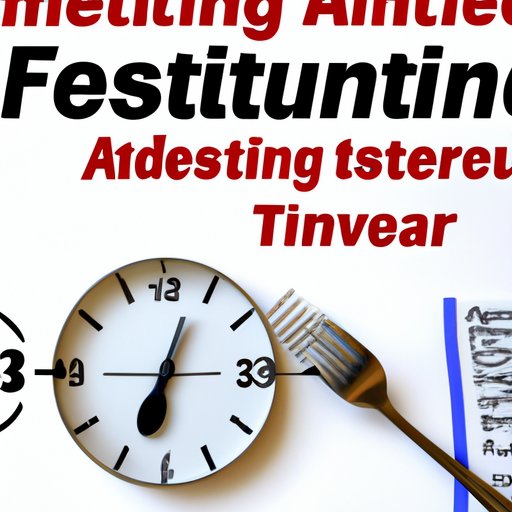
I. Introduction
If you’re struggling with weight loss, you’re not alone. Millions of people around the world are trying to shed excess weight and improve their health, but it’s not always easy. However, there is a solution that has been gaining popularity in recent years: intermittent fasting. In this article, we will explore how intermittent fasting can help you lose weight effectively.
II. The Ultimate Guide to Intermittent Fasting for Effective Weight Loss
Intermittent fasting (IF) is a pattern of eating and fasting periods. Unlike conventional diets, it does not focus on what to eat but rather when to eat. There are several types of intermittent fasting, including time-restricted feeding, alternate-day fasting, and periodic fasting. Intermittent fasting has many benefits, such as reducing inflammation, improving insulin sensitivity, and boosting autophagy.
But how does intermittent fasting help with weight loss? When you fast, your body uses stored fat for energy, which leads to a calorie deficit and therefore weight loss. Additionally, intermittent fasting has been shown to reduce hunger and increase satiety hormones, making it easier to control food intake during eating periods.
Getting started with intermittent fasting can be daunting, but some tips can make it easier. For example, start with shorter fasting intervals and gradually increase the length of fasting periods. Drink plenty of water to stay hydrated and avoid overeating during eating periods to prevent sabotaging your weight loss goals.
III. 5 Intermittent Fasting Strategies That Work
There are various fasting strategies you can choose from, depending on your lifestyle and goals. Here are five popular approaches:
- Time-restricted feeding (TRF) – This approach involves eating within a specific window of time and fasting for the rest. For example, you might eat only during an eight-hour period and fast for the remaining sixteen hours.
- Alternate-day fasting (ADF) – This method involves fasting for 24 hours every other day and consuming a normal diet on non-fasting days.
- 5:2 diet – This approach involves limiting calorie intake to 500-600 calories on two non-consecutive days of the week and eating normally on the remaining five days.
- Periodic fasting – This method involves longer periods of fasting, ranging from one to several days, several times per year.
- Modified fasting – This approach involves reducing calorie intake by 20-25% every day.
It’s best to choose an approach that fits your lifestyle, goals, and eating preferences. Consult a healthcare provider if you have any underlying health conditions or concerns.
IV. The Benefits of Combining Intermittent Fasting with Exercise
Physical activity is an essential component of any weight loss plan. When combined with intermittent fasting, it can enhance the effects of weight loss. Fasting before exercise can increase the use of stored fat for energy and promote fat loss. It can also improve insulin sensitivity, leading to better glucose control and fewer cravings.
When it comes to choosing the right exercise routine, high-intensity interval training (HIIT) and resistance training are among the most effective for weight loss. HIIT involves short bursts of intense exercise followed by periods of rest. Resistance training involves working with weights to build muscle, which can increase metabolic rate and improve body composition.
V. Foods to Eat and Avoid When Intermittent Fasting to Maximize Weight Loss
During fasting periods, it’s essential to avoid consuming calories, which can break the fast. However, it’s equally important to eat nutritious foods during eating periods.
Some of the best foods to eat during intermittent fasting include:
- Lean protein sources, such as chicken, fish, and tofu
- Non-starchy vegetables, such as leafy greens, broccoli, and peppers
- Healthy fats, such as avocado, nuts, and olive oil
On the other hand, you should avoid consuming sugary and processed foods, as they can sabotage your weight loss goals. Foods to avoid during eating periods include:
- Sugary drinks, such as soda and juice
- Processed snacks, such as chips and cookies
- High-carb foods, such as bread and pasta
It’s essential to plan your meals ahead of time to ensure you’re sticking to healthy foods and not breaking your fast unintentionally. Meal prepping can be a helpful way to stay on track with your goals.
VI. The Do’s and Don’ts of Intermittent Fasting for Effective Weight Loss
As with any weight loss plan, there are certain tips and tricks that can help you achieve your goals more effectively. Here are some dos and don’ts for intermittent fasting:
- Do stay hydrated – Drink plenty of water, herbal tea, and other hydration fluids to prevent dehydration and curb hunger cravings.
- Do plan meals ahead of time – Meal planning can ensure you’re sticking to healthy foods and not unintentionally breaking your fast.
- Don’t overeat during eating periods – While it’s essential to eat enough to fuel your body, overeating during eating periods can sabotage your weight loss goals.
- Don’t consume calories during fasting periods – Even small amounts of calories can break your fast and sabotage your weight loss goals.
- Don’t give up too soon – It can take a few weeks for your body to adjust to intermittent fasting, so don’t give up too soon if you’re not seeing results right away.
There are many myths and misconceptions about intermittent fasting, such as it slows your metabolism or causes muscle loss. However, studies have shown that intermittent fasting can be a safe and effective weight loss strategy when done correctly.
VII. Conclusion
Intermittent fasting can be an effective weight loss strategy, offering numerous benefits beyond just weight loss. By defining what intermittent fasting is, exploring different strategies, highlighting how it complements exercise routines, detailing the foods to eat and avoid, and sharing the do’s and don’ts of intermittent fasting, people can make better decisions about the lifestyle changes they want to take. By following these guidelines and staying committed to intermittent fasting, people can improve their health and wellbeing.





